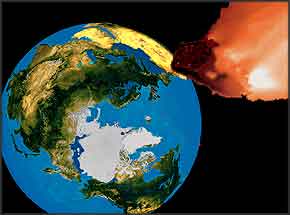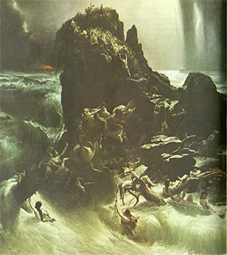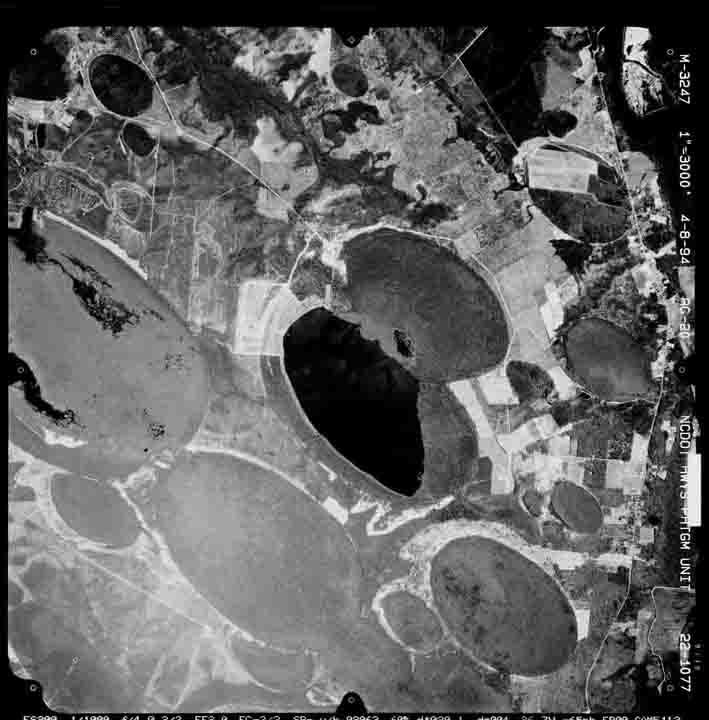![]()
![]()
DID A COMET CAUSE FIRESTORM THAT DEVESTATED NORTH AMERICA 12,900 YEARS AGO?

A REPORT BY ANDREW COLLINS, 26 MAY 07
New evidence has emerged demonstrating that a deadly comet devastated North America some 12,900 years ago, causing unimaginable firestorms, the return of the ice age and a 70 percent destruction of human population, according to the findings of 25 strong research team.
This incredible view of events centred around the end of the geological era known as the Pleistocene was presented last week to a stunned audience at the American Geophysical Union meeting in Acapulco, Mexico. It features also in the latest issue of NEW SCIENTIST magazine (194:2605, 26 May 2007, 8-9), from which this story is taken.
Scientists now believe that the cause of this continental sized cataclysm was a disintegrating comet, which fractured into tiny pieces as it entered the atmosphere from the north or northwest, causing massive explosions and fireballs.
A Continent on Fire
One of the three-main scientists speaking on behalf of the team, Jim Kennett, an oceanographer at the University of California, Santa Barbara, showed striking evidence from several sites of large scale wildfires that torched North America in the wake of the comet break-up. In his words: 'The whole continent was on fire.'
Evidence comes from a narrow 12,900 year old carbon-rich layer of sediment uncovered at no less than eight sites belonging to a level known as the Clovis horizon, as well as from several other sample sites of sediment in North America.
Extraterrestrial Debris
At many of the sites the scientific team have uncovered evidence of extraterrestrial debris, including what they refer to as nanodiamonds, tiny glass-like spherules which form rapidly when molten droplets cool rapidly in the air. They form usually during comet or asteroid impacts. Also discovered at the sites were rare helium-3 molecules, which are more common in deep space than on Earth.
'You might find some other explanation for these individually,' said Richard Firestone, a nuclear analytical chemist working at Lawrence Berkeley National Laboratory in California, 'but taken together, it's pretty clear that there was an impact.'
He also believes that the obvious culprit is a comet strike, since the key sediment layers examined thus far have not produced characteristic evidence of high nickel and iridium content, found in connection with asteroid and meteorite impacts, such as that found in connection with the so-called KT Boundary Event suspected of wiping out the dinosaurs some 65 million years ago.
Obvious Skepticism
Naturally there is going to be wide scale objection to this staggering new theory, which has immense implications in other areas of science and literature, including the reality of Plato's account of the destruction of Atlantis, which might well preserve a memory of the comet's impact on the Bahamas and Caribbean (see below). Many scientists, particularly those who believe that global cataclysms very rarely rock the world, are strictly against the team's theories.
'There is a tendency in this field to label any circular feature a crater,' says Michael Oskin of the University of North Carolina in Chapel Hill, who surely had in mind the famous Carolina Bays when he said these words. These are literally ten of thousands of elliptical craters, orientated northwest to southeast that cover large areas of not just the Carolinas but several states from New Jersey down to Florida. Many are in swampland and filled with water, thus are taken simply to be wind-created lakes or ponds. Ever since their discovery in the 1930s, following the advent of aerial photography, there has been mounting speculation that the Carolina Bays, and other similar elliptical craters in the Yukon permafrost, are impact craters caused by either the aerial bombardment of meteorites, or the fragments of
|
Aerial picture of the Carolina Bays |
some
more substantial object such a comet or asteroid, similar to
the one suspected of causing an explosion of immense magnitude
in a remote forested region in Tunguska, Siberia, in 1908. Speaking of Oskin's skepticism, Asish Basu, a geochemist at the University of Rochester, New York, believes that the findings presented by the team are sound, and their evidence for an extraterrestrial explosion is convincing. 'I think it is a very straight forward case of an impact.' |
It Came From the North
Since no large impact site has yet been found, Arizona-based geophysicist and team member Allen West, likewise offers the solution that the object was 'a low density object', i.e. a comet that fragmented into many pieces as it entered the atmosphere, causing a series of 'massive aerial explosions', each one similar to what happened in Tunguska, which spread gradually southwards.
So far no epicentre for the proposed cataclysm has been determined, though the geologists are currently searching in the north of the North American continent, where some of the highest levels of extraterrestrial material have been found. This includes an archaeological site at Gainey in Michigan,
|
Province of Ontario below Hudson's Bay. |
which
in 12,900 BP lay just beyond the southernmost reach of North American's
primary ice sheet as it receded around the end of the last Ice
Age. Levels of extraterrestrial debris seem to decease further south, suggesting that the comet might well have blown up over Ontario or the Hudson's Bay area. Geologists believe that the Great Lakes could well provide vital clues of the catastrophe. Team member Richard Firestone has detected 'four large holes in the lakes which are deeper than Death Valley, so we kind of suspect that pieces of this impact did penetrate them.' |
A 400-kilometre long anomaly in Hudson's Bay is also being investigated as a possible rim of a giant impact crater. Yet if the comet did approach from the north or northwest, then it is likely that the largest and heaviest fragments reached beyond the southeastern extent of the Carolina Bays, meaning that marine geologists should be looking in the West Atlantic Basin for further evidence of the impact (a subject also dealt with below).
Another possibility is that the main impact crater was created in the hundreds of metres thick ice sheet north of Michigan, which would have disintegrated, leaving relatively few traces, when finally the ice melted, bringing an end to the last Ice Age.
Younger Dryas
Another angle of this powerful discovery is that the 12,900 BP time-frame offered by the evidence of the overall cataclysm fits very well with the sudden re-advance of the ice sheet following some 2,000 years when it had been in withdrawal. This is known to geologists and climatologists as the Younger Dryas.
In the past, the Younger Dryas was put down to climate changes caused by melt waters from the ice sheets flowing into the Great Lakes, and then south through the Mississippi river into the Gulf of Mexico. This then allowed melt water to flow eastward into the Atlantic Ocean, helping to 'switch off' the ocean's saltwater-driven 'conveyor belt' current, bringing the entire Gulf Steam to a halt and triggering a mini ice age.
Now, however, there is growing speculation that the Younger Dryas might well have resulted from airborne debris caused by the impact and subsequent firestorms blocking out sunlight, as well as the release of melt water from the primary ice sheet that would indeed have flowed eastwards, opening up new drainage channels into the Atlantic Ocean.
'What we suggest is that the meltwater outflow from the proglacial lakes and from the temporarily melting ice sheet was the result of extraterrestrial impact,' Jim Kennett explains.
At the same time no less that 35 genera of the continent's species suddenly became extinct including camels, mastodons, ground sloths and horses, while the Clovis culture, which had flourished for at least a thousand years, diminished by an estimated 70 percent. Previously, the extinction of the Pleistocene animal species has been put down either to the advent of a mini ice age, the Younger Dryas, or over hunting on the part of the hunter-gathering Clovis culture.
However, from 12,900-year-old carbon-rich layers at Murray Springs, Arizona, as well as in sediment cores extracted from examples of the Carolina Bays, chemist Wendy Wolbach has detected 'significant quantities of soot', which is unquestionably a product of intense wildfires. Polycyclic aromatic hydrocarbons - another signature of wildfires, has also been detected at the team's sites by geologist Luanne Becker of the University of California, Santa Barbara.
The conclusion is obvious say the team. Huge wildfires swept across the North American continent following the impacts, destroying whole populations of animals and humans. 'I don't want to sound catastrophic here,' said Kennett, 'but this is wild stuff. There is significant evidence of massive biomass burning.'
Archaeologist Al Goodyear of the University of South Carolina, told the conference that there is 'indirect evidence of a human disaster in what is now the south-eastern US'. Distinctive style Clovis points suddenly disappear, only to be replaced around 12,700 BP by another style known collectively as 'red points'. These then outnumber the Clovis point 4 to 1, which if an indication of the rapid depletion of the population, strongly hints that up to 70 percent of the Clovis population no longer existed.
As previously mentioned, it is going to be a hard struggle convincing cataclysm skeptics of this incredible new scenario at the end of the Pleistocene epoch. As Kennett jokes: 'You watch it, there will be blood on the streets.'
For further information, see the New Scientist online story 'Did a comet wipe out prehistoric Americans' found at http://space.newscientist.com/article/mg19426052.900-firestorm-from-space-wiped-out-prehistoric-americans.html
THE NORTH AMERICAN COMET THEORY
THE GREATER IMPLICATIONS FOR PLATO'S STORY OF ATLANTIS

In the year 2000 my book GATEWAY TO ATLANTIS was published for the first time. It proposed that Plato's concept of Atlantis was based on stories reaching the Mediterranean in Plato's age, c. 350 BC, of an immense cataclysm that had rocked the Bahamas and Caribbean at the end of the Pleistocene epoch, causing fire to rain from the sky, unimaginable tsunamis and the drowning of an antire island empire. Cuba was singled out as matching very well the description of Atlantis's central island, while the Bahamas was almost certainly the sunken lands where according to Plato following the cataclysm no ocean going vessel could any longer pass since it was now too shallow (which the Bahamas unquestionably is, following the rise of the oceans at the end of the last Ice Age).
The cataclysm I predicted was responsible for the destruction of Atlantis is identical to that being cited by the 25 strong scientific team at the American Geophysical Union last week. Using available evidence on the structure and dating of the Carolina Bays, a knowledge of the firestorms recorded in settlements across the United States, as well as details of the flow of ice melt waters and the mass extinction of Pleistocene animals, I concluded that a comet had come out of the north-western skies and disintegrated into countless pieces, causing tens of thousands of aerial detonations across North America. This resulted in wide scale firestorms, massive explosions, tens of thousands of elliptical craters from the Yukon down to Florida, as well as the onset of the Younger Dryas, or mini ice age. This in turn led eventually to the end of the last Ice Age, with the drowning eventually of large areas of the Bahamas and Caribbean.
This much is now being proved correct, but if this is the case then scientists should also look at what I said happened as a result of this comet impact. German rocket scientist Otto Muck in his book THE SECRET OF ATLANTIS (1978, 1st UK edition) was the first to point out the existence of massive elliptical craters in the West Atlantic Basin, off the coast of Florida. He proposed that these were the result of an asteroid strike, which caused tremendous underwater earthquakes, ripping apart the tectonic plates that join to form the Great Atlantic Rift, and sinking a whole island continent that sat astride the ridge in the vicinity of the Azores group. This, of course, Muck concluded was the lost continent of Atlantis.
No evidence of this former island continent has ever come to light, even though the Mid Atlantic has been the chosen site of Atlantis ever since the theory was first proposed by granddaddy of Atlantology Ignatius Donnelly back in 1882. Curiously, Donnelly was one of the first to take seriously the theory of a major cataclysm hitting the North American continent and causing mass devastation towards the end of the Pleistocene epoch. It was the main thrust of his invaluable book RAGNORAK: THE AGE OF FIRE AND GRAVEL (1883).
Using Muck's lead, I proposed in GATEWAY TO ATLANTIS that the apparent gigantic craters in the West Atlantic Basin were perhaps evidence of the largest parts of the aforementioned comet overshooting North America and crashing into the ocean. If so, then this would have produced massive underwater earthquakes and unimaginable tsunamis that would have devastated the Bahamas and Caribbean to the south.
In addition to this, I found evidence of the presence on Cuba of the giant sloth, a Pleistocene animal supposed wiped out at the end of the last Ice Age, most obviously be over hunting. Yet according to orthodox thinking, no human set foot in the Caribbean until around 5000 BC. So how was the giant sloth wiped out in Cuba? I also found evidence for the existence of species of snake on different Caribbean islands that can only have thrived when the islands were linked together, and yet their differences were such as to suggest a recent parting of the waves. Beyond this were myths and legends preserved among the former indigenous peoples of the Caribbean, as well as by their descendents in South and Central America, that spoke of a time when all the islands were as one. Then came a fire out of the sky, which was followed by massive flooding that twice split the islands apart. Afro-Caribbean islanders on Tobago even spoke of a time when the islands divided after the 'old moon broke' and came crashing into the sea, presumably having learnt such stories from the native peoples they encountered on their arrival in the Caribbean.
All of the myths and legends, which derive from Bahamas in the north to the Lesser Antilles in the south, could be accounted for if it was shown that the larger fragments of the comet which had fragmented over North America at the end of the Pleistocene epoch ended up in the Western Atlantic Basin. If so, then there was every chance that almost all of the indigenous populations of the islands would have been wiped out, with only a few survivors left to tell the tale. Such stories were then retold across millennia, both in the islands and also by their descendents on the mainland, until finally they were conveyed to incoming Mediterranean traders either prior to or during the life of Plato, in the same way that similar stories were retold to the first explorers to reach these same isles in the wake of Columbus.
These 'voyagers', the term used by Plato in his dialogue entitled the 'Timaeus', and later in the 'Critias', were most probably either Phoenicians out of Southern Spain or Carthaginians out of North Africa. Their crews would have docked at Mediterranean ports such as those on Sicily, which in Plato's time was in Carthaginian hands. Having spent time there himself, he might easily have come across these rumours and stories of a once great island empire across the 'Atlantic Sea', devastated by earthquakes and floods, and so decided to include them in his dialogues. One clue is the repeated use of Semitic names in his Atlantis account, showing that his primary maritime sources came not from Egypt, as has always been assumed (due to the dialogues' use of Solon as the collector of these tales from the old priest of Sais in Egypt), but from either Phoenician or Carthaginian sources, who spoke forms of the Semitic language.
Plato's suggestion that the cataclysm which devastated Atlantis either took place in 8500 BC (found in the 'Timaeus') or 9500 BC (found in the 'Critias'), is very close to the proposed dates for the end of the Pleistocene epoch. However, I suspect that these were the only real clues he got from Egypt, for they are very close to the time-frames given in temple chronologies for the age of the gods and demi-gods in ancient Egyptian tradition. Thus their connection with the destruction of Atlantis is merely a happy coincidence, although one that is now proving to be bizarrely accurate.
In my opinion, there is compelling evidence that the Bahamas and Caribbean once supported a high culture with maritime capabilities prior to the cataclysm which devastated their island civilization. More and more examples of vast underwater features of human construction are coming to light off key Bahaman islands such as Bimini and Andros through the scientific work of Greg and Lora Little, and if it can be established that these predate what I call the Carolina Bays event, then this forms an important missing piece of the puzzle in our understanding of this cataclysm and its effects on the development of the Atlantic myth.

|
I sincerely hope that people will re-examine the proposals in GATEWAY TO ATLANTIS, for they are now being authenticated by new and exciting findings that challenge the way we think about the past. To obtain copies of GATEWAY TO ATLANTIS via the website click here. To read more about my work on Atlantis go now to the index of the website's Atlantis section by clicking here. |
![]()
![]()

